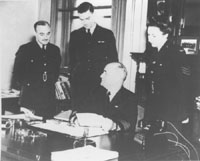


RAAF Meteorological Service
Foreword
Introduction
Chapter 1: The Weather Factor in Warfare
Chapter 2: Establishing and Developing the RAAF Directorate of Met. Services (D.Met.S)
Chapter 3: Recruiting and Training of Personnel
Chapter 4: Meteorology in Aviation
Chapter 5: The Met. Retreating
Chapter 6: The Met. Advancing
Chapter 7: The Met With the Army and the Navy
Chapter 8: Divisional Offices of the Bureau of Meteorology During the War
Chapter 9: Research and Instrumental Development
Chapter 10: The End, Aftermath, and Beyond
Appendix 1
Appendix 2
Appendix 3
Appendix 4
References
Index
Search
Help
Contact us

A phrase that every serviceman knew well was 'as you were'. It meant return to your former situation, and was freely used in orders. Yet, wars leave few things as they were. One of the few unassailable things is the weather. The two world wars of the twentieth century (to date)—particularly the second conflict—have greatly accelerated improvement of technology and techniques in meteorology, as in many other fields, bringing home the truth that hostility can be the motivator of invention. Australian meteorology emerged from World War II modernised and strengthened. Valuable knowledge had been acquired, and new equipment developed, and meteorology had been firmly established as a science. The understanding of the weather in northern Australia and the adjacent tropical regions had been significantly increased.
The last three decades have witnessed the refinement of the old and the invention of various new meteorological instruments, including weather radar, refined radiosondes, satellites, and computers. These have provided meteorological information in quantity and quality which has greatly improved the accuracy of forecasting. For his role in meteorological research and investigation, Wing-Commander H. Treloar was awarded the Honorary degree of Doctor of Science at The University of Melbourne—the first such award in Australia for meteorological work.
After the war, meteorological equipment, in the main, was produced locally. Repair and maintenance have been carried out in Australian workshops and laboratories.
The war had clearly shown the need for international cooperation if our knowledge of meteorological processes was to be kept up-dated and applied effectively. Australian meteorologists played leading roles on the international scene. Former Group-Captain H. N. Warren, who resumed his post as Commonwealth Director of Meteorology post-war, was chairman of a committee formed to prepare a draft convention for the World Meteorological Organization (WMO). Successive Australian Met. Service directors have served as members of this organisation; other members have served on technical commissions and working groups, or have contributed to WMO publications. Australian meteorologists have been involved in such projects as the World Weather Watch, the International Geophysical Year (1957), the Global Atmospheric Research Program, Southern Ocean-Antarctic meteorology and earth satellite development.

People in Bright Sparcs - Treloar, Harry Mayne; Warren, Herbert Norman
 |
Bureau of Meteorology |  |
© Online Edition Australian Science and Technology Heritage Centre and Bureau of Meteorology 2001
Published by Australian Science and Technology Heritage Centre, using the Web Academic Resource Publisher
http://www.austehc.unimelb.edu.au/fam/0330.html